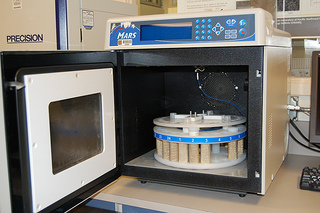Zapping PV in the microwave might make it cheaper
 Tomorrow’s nano-photovoltaic materials may get a boost thanks to one of everyone’s favorite kitchen devices, the microwave oven. New research from Oregon State University finds that microwave ovens could be an important tool for manufacturing nanomaterial photovoltaic semiconductors.
Tomorrow’s nano-photovoltaic materials may get a boost thanks to one of everyone’s favorite kitchen devices, the microwave oven. New research from Oregon State University finds that microwave ovens could be an important tool for manufacturing nanomaterial photovoltaic semiconductors.
The university is using the proverbial zapper to treat the nanomaterials, like nanoinks, prior to applying them to a backing sheet. “This is essentially to get the proper crystal structure of the material prior to applying to the pane,” said Greg Herman, an associate professor at the School of Chemical, Biological and Environmental Engineering at OSU.
The microwave ovens are being used to heat the semiconducting materials to high temperatures, about 400 degrees Celsius. “Typically with the nanomaterials that are made to put in solar cells usually you need to perform these at high temperature to get what you’re looking for,” Herman said. Such reactions are able to make quantum dots and other nanomaterials capable of being a PV semiconductor.
Traditionally these reactions have been carried out in conventional ovens, which don’t provide coverage as evenly as microwaves. Microwaves, according to Herman, can apply a more even heat source giving a more universal treatment to the materials. Also, it takes less energy to run a microwave than a conventional oven. Microwaves are already used in industrial processes and could be harnessed for producing the nanomaterials. “This was done in a batch mode. We’re looking at continuous flow synthesis for the formation of materials,” he said.
“The goal of all this work is that it can be done in ambient conditions,” Herman said. In tests all the processing for the test solar cells, made of copper zinc tin sulfide, was done at ambient conditions, or with flowing nitrogen to prevent oxygen from penetrating the materials. Still, when they published the research in Physica Status Solidi, the efficiency at this point was low, at about .25 percent. “That was our first cell with this material,” he said.
The researchers are also experimenting with using microwaves to synthesize other nanomaterial PV semiconductors, including copper indium diselenide and lead sulfide, according to Herman.



